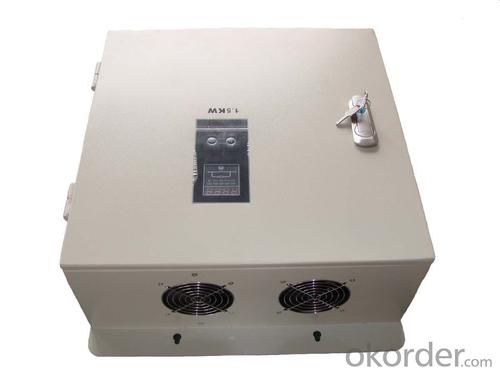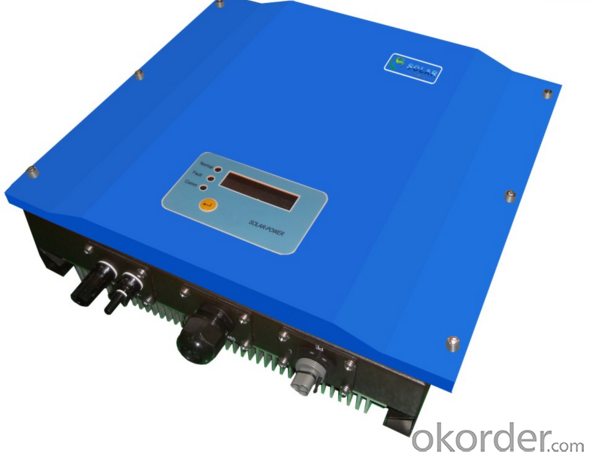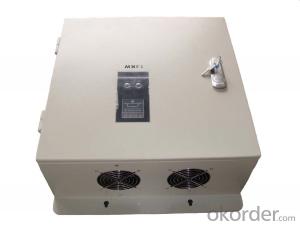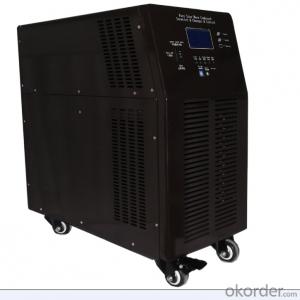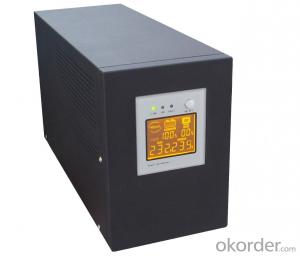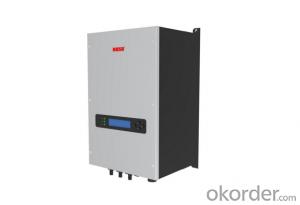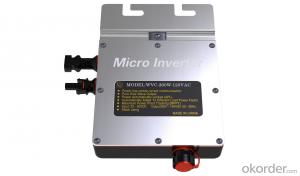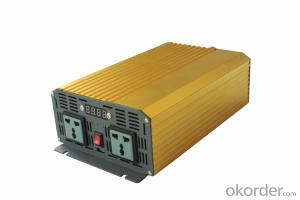Abb Uno Solar Inverter Single Phase 1.5kW Made in China
- Loading Port:
- Shanghai
- Payment Terms:
- TT OR LC
- Min Order Qty:
- 0 watt
- Supply Capability:
- 10000 watt/month
OKorder Service Pledge
OKorder Financial Service
You Might Also Like
Description of Single Phase1.5K Inverter
Solar ac power system consists of solar panels, charge controllers, inverter and battery; Solar energy does not include inverter dc power system. Inverter is a kind of power conversion device, inverter by incentives can be divided into self-excited oscillation inverter and separately excited oscillation inverter.
Features of Single Phase1.5K Inverter
High MPPT accuracy(>99.9%)
Wide DC input range (60~300 Vdc), compatible with different module
Easy to wire, install and operate
IP65 design, suitable for indoor and outdoor installation
10 years warranty(5~25 years optional)
Technical Data of Single Phase1.5K Inverter
| Type | Omniksol-1.5k-TL-M |
| Input(DC) | |
| Max.PV Power | 1.5kW |
| Max,DC Voltage | 400V |
| Operating MPPT Voltage Range | 60-300V |
| MPPT Voltage Range at Nominal Power | 125-300V |
| Start up DC Voltage | 70V |
| Turn off DC Voltage | 50V |
| Max, DC Current | 10A |
| Max, Short Cicuit Current for each MPPT | 12A |
| Number of MPP trackers | 1 |
| Number of DC Connection for each MPPT | 1 |
| DC Connection Type | MC4 connector |
| Output(AC) | |
| Max,AC Apparent Power | 1250VA |
| Nominal AC Power (cos phi = 1) | 1250W |
| Nominal Grid Voltage | 220V/230V/240V |
| Nominal Grid Frequency | 50Hz/60Hz |
| Max, AC Current | 6.25A |
| Grid Voltage Range** | 185-276V |
| Grid Frequency Range** | 45-55Hz/55-65Hz |
| Power Factor | >0.99 |
| Total Harmonic Distortion(THD) | <3% |
| Feed in Starting Power | 30W |
| Night time Power Consumption | <1W |
| Standby Consumption | 6W |
| AC Connection Type | Plug-in connertor |
| Efficiency | |
| Max,Efficiency | 95.5% |
| Euro Efficiency | 94.2% |
| MPPT Efficiency | 99.9% |
| Safety and Protection | |
| DC Insulation Monitoring | Yes |
| DC Switch | Optional |
| Residual Current Monitoring Unit (RCMU) | Integrated |
| Grid Monitoring with Anti-islanding | Yes |
| Protection Class | Ⅰ(According to IEC 62103) |
| Overvoltage Category | PV Ⅱ/ Mains Ⅲ(According to IEC 62109-1) |
| Reference Standard | |
| Safety Standard | EN 62109, AS/NZS 3100 |
| EMC Standard | EN 6100-6-1, EN 6100-6-2, EN 6100-6-3 EN 6100-6-4, EN 6100-3-2, EN 6100-3-3 |
| Grid Standard | VDE-AR-N4105. VDE-0126-1-1,G83/1,EN 50438,RD1699,CEI 0-21, AS4777,C10/C11 |
| Physical Structure | |
| Dimensions | 210x297x90mm |
| Weight | 5.5kg |
| Environmental Protection Rating | IP 65 (According to IEC 60529) |
| Cooling Concept | Natural convection |
| Mounting Information | Wall bracket |
| General Data | |
| Operating Temperature Range | -25℃ to +60℃(derating above 45℃) |
| Relative Humidity | 0% to 98%, no condensation |
| Max. Altitude (above sea level) | 2000m |
| Noise Type | <45dB |
| Isolation Type | Transformerless |
| Display | 2LED Backlight 16*2 Character LCD |
| Data Communication | RS485(WiFi, GRPS optional) |
| Computer Communication | RS232 as option |
| Standard Warranty | 10 Years (5-25 years optional) |
IMages of Single Phase1.5K Inverter

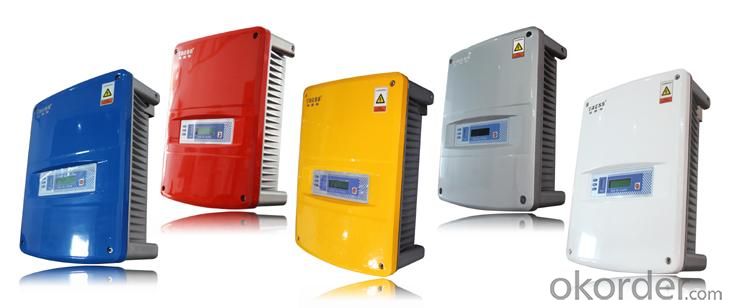
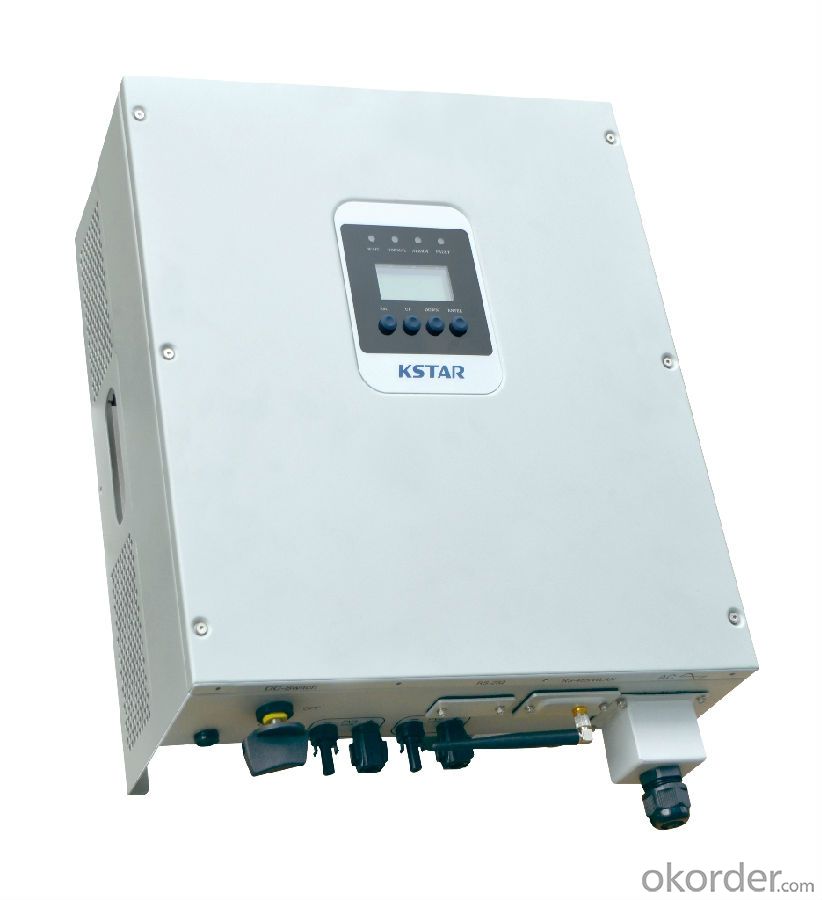
FAQ
Q: Do you have the CE, TUV, UL Certification?
A: We’ve already passed all the tests, and any certificate is available.
Q: Have you ever sold your products to companies in my country?
A: Of course, we have customers in all general PV markets, but I think we should expand our market share along with the market growth.
Q: When did your company set up? You are a new company, how can I believe your quality?
A: We entered into Solar PV industry in 2005, now we have several plants in manufacturing of a-Si and c-Si panels, and our capacity is 220MW per year. Till now we have already passed all the tests by authorized laboratories, e.g. TUV, CE, UL.
Q: Can you help us install the module if we cooperate with you?
A: We haven’t entered into installation sector, but we have the plan in near future.
Q: How do you pack your products?
A: We have rich experience on how to pack the panels to make sure the safety on shipment when it arrives at the destination.
Q: Can you do OEM for us?
A: Yes, we can.
Q: Can we visit your factory?
A: Surely, I will arrange the trip basing on your business schedule.
- Q: Can a solar inverter be used with a solar-powered irrigation system?
- Yes, a solar inverter can be used with a solar-powered irrigation system. The solar inverter is responsible for converting the direct current (DC) generated by the solar panels into alternating current (AC) that can be used to power the irrigation system. This allows the solar energy to be efficiently utilized for irrigation purposes.
- Q: Can a solar inverter be used in grid-tied systems?
- Yes, a solar inverter can be used in grid-tied systems. In fact, a solar inverter is an essential component of a grid-tied system as it converts the direct current (DC) produced by the solar panels into alternating current (AC) that can be fed into the electrical grid. This allows for the efficient utilization of solar energy and enables homeowners or businesses to offset their electricity consumption with solar power, potentially even earning credits for excess energy produced.
- Q: What is the typical installation process for a solar inverter?
- The typical installation process for a solar inverter involves several steps. First, a suitable location for the inverter is identified, usually near the solar panels. The inverter is then mounted securely on a wall or other structure. Next, the DC wiring from the solar panels is connected to the input terminals of the inverter, ensuring proper polarity. The AC output terminals of the inverter are then connected to the electrical panel of the building, often through a dedicated circuit breaker. Finally, the inverter is connected to the monitoring system to track its performance and ensure optimal energy production. It is important to follow the manufacturer's instructions and consult a professional electrician to ensure a safe and efficient installation.
- Q: How does a solar inverter handle voltage dips or fluctuations in the grid?
- A solar inverter handles voltage dips or fluctuations in the grid by constantly monitoring the grid voltage. When it detects a dip or fluctuation, it adjusts its own output voltage accordingly to maintain a stable and consistent power supply. This helps protect connected devices from potential damage and ensures that the solar system continues to operate efficiently.
- Q: What is the difference between a centralized and decentralized solar inverter system?
- A centralized solar inverter system involves connecting multiple solar panels to a single inverter, with all the panels connected in series. The combined DC power generated by the panels is then converted into AC power by the centralized inverter. On the other hand, a decentralized solar inverter system, also known as microinverters or power optimizers, consists of each solar panel having its own dedicated inverter. In this system, each panel operates independently and converts its DC power into AC power directly at the panel level. The main distinction between the two systems lies in their architecture and power conversion methods. In a centralized system, the overall power output of the entire array depends on the performance of a single inverter. If any panel in the array underperforms due to shading or malfunction, it can significantly impact the overall system's performance. Additionally, a single inverter can limit design flexibility and system scalability. In a decentralized system, each panel operates independently, allowing for greater flexibility and optimization. The individual inverters in a decentralized system can maximize the power output of each panel, regardless of shading or performance variations. This also means that the overall system performance is less affected by the underperformance of a single panel. Moreover, decentralized systems offer better scalability as additional panels can be easily added without the need for significant system redesign. Decentralized systems also provide improved monitoring capabilities, as each inverter can provide real-time data on individual panel performance. This simplifies troubleshooting, maintenance, and issue identification within the solar array. To summarize, while a centralized solar inverter system is a simpler and more cost-effective option, a decentralized system offers better optimization, scalability, monitoring, and performance reliability. Choosing between the two systems depends on factors such as system size, shading conditions, budget, and desired level of control and flexibility.
- Q: Are there any government incentives for installing solar inverters?
- Yes, there are government incentives for installing solar inverters. In many countries, governments offer tax credits, rebates, grants, and other financial incentives to promote the adoption of renewable energy technologies, including solar inverters. These incentives aim to reduce the upfront costs of installation and make solar energy more affordable and accessible to individuals and businesses.
- Q: Can a solar inverter be used with different types of energy storage systems?
- Yes, a solar inverter can be used with different types of energy storage systems. Solar inverters are designed to convert the direct current (DC) generated by solar panels into alternating current (AC) that can be used to power electrical devices. The AC output from the solar inverter can be connected to various energy storage systems, such as batteries, to store excess energy generated by the solar panels for later use. Therefore, solar inverters are compatible with different types of energy storage systems, allowing for efficient utilization of solar energy.
- Q: How does a solar inverter synchronize with the electrical grid?
- A solar inverter synchronizes with the electrical grid through a process called grid synchronization. This involves the inverter constantly monitoring the voltage and frequency of the grid and adjusting its own output accordingly to match the grid's parameters. Once the inverter's output matches the grid's voltage and frequency, it can seamlessly feed the solar-generated electricity into the grid, ensuring safe and efficient integration of solar power into the existing electrical infrastructure.
- Q: Can a solar inverter be used in regions with high humidity or moisture levels?
- Yes, solar inverters can be used in regions with high humidity or moisture levels. However, it is important to ensure that the inverters are designed and built to withstand such conditions. Waterproof or moisture-resistant features may be necessary to protect the inverters from potential damage caused by moisture or humidity. Regular maintenance and monitoring are also recommended to ensure optimal performance in such environments.
- Q: Can a solar inverter be used with a solar-powered cooling system?
- Yes, a solar inverter can be used with a solar-powered cooling system. The solar inverter converts the direct current (DC) generated by the solar panels into alternating current (AC) that can be used to power various electrical devices, including the cooling system. This allows for the efficient use of solar energy to run the cooling system, reducing reliance on grid electricity and promoting sustainability.
Send your message to us
Abb Uno Solar Inverter Single Phase 1.5kW Made in China
- Loading Port:
- Shanghai
- Payment Terms:
- TT OR LC
- Min Order Qty:
- 0 watt
- Supply Capability:
- 10000 watt/month
OKorder Service Pledge
OKorder Financial Service
Similar products
Hot products
Hot Searches
Related keywords



